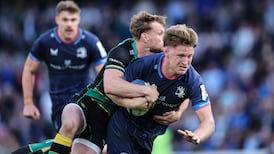BLAME the proximity of the British Open and the declared wish by Jack Nicklaus to fade quietly from the major championships into the golfing sunset. I refer to the almost frenzied renewal of interest in rating the world's greatest exponents of the game an exercise which receives considerable prominence in the current issue of "Today's Golfer.
The British magazine asked its readers to nominate their top 50 golfers of all time. There is no Fred Daly nor Christy O'Connor Snr but, interestingly, the list includes no fewer than seven players (14 per cent), who have been challenging for the Murphy's Irish Open at Druids Glen this week.
The top 50 are 1 Jack Nicklaus (18 professional major championships) 2 Nick Faldo (6); 3 Seve Ballesteros (5); 4 Gary Player (9); 5 Arnold Palmer (7); 6 Greg Norman (2); 7 Ben Hogan (9); 8 Tom Watson (8); 9 Bobby Jones (13), professional and amateur; 10 Lee Trevino (6); 11 Sam Snead (8); 12 Ian Woosnam (1); 13 Fred Couples (1); 14 Walter Hagen (11); 15 Bernhard Langer (2); 16 Harry Vardon (7); 17 Colin Montgomerie (0); 18 John Daly (2); 19 Nick Price (3); 20 Sandy Lyle (2); 21 Byron Nelson (5); 22 Tony Jacklin (2); 23 Henry Cotton (3); 24 Gene Sarazen (5); 25 Ernie Els (1); 27 Ben Crenshaw (2); 28 Tom Kite (1); 29 Johnny Miller (2); 30 Sam Torrance (0); 31 Corey Pavin (1); 32 Jose Maria Olazabal (1); 33 Bob Charles (1); 34 David Graham (2); 35 Tom Weiskopf (1); 36 Tom Morris Jnr (4); 37 Peter Thomson (5); 38 Tommy Horton (0); 39 Payne Stewart (2); 40 Raymond Floyd (4); 41 James Braid (5); 42 Hale Irwin (3); 43 Larry Nelson (3); 44 Laura Davies (2); 45 Curtis Strange (2); 46 J H Taylor (5); 47 Craig Stadler (1); 48 Fuzzy Zoeller (2); 49 Roberto de Vicenzo (1); 50 Steve Elkington (1).
While accepting an understandable British bias in the list, it is fascinating to note the extent to which Tony Jacklin has become yesterday's man, being rated lower than Woosnam, Montgomerie and even Americans such as Couples and Daly. Still, it's all grist to the old mill at the 19th.
SHOULD an erratic golfer be obliged to shout "Fore" before striking the ball, on the assumption that he is likely to produce yet another wayward stroke? That is the intriguing decision facing a jury in the New York Supreme Court.
The case concerns an investment banker and his suit against a fellow employee whose sliced tee shot struck him as he stood on a clubhouse balcony. The plaintiff is contending that the slice by the 32 handicapper was foreseeable because his three previous strokes were all off line. Furthermore, he didn't shout a warning until after he hit the ball. The outcome is awaited with interest.
SHORT of smashing a 500 yard drive while suspended by one leg from a trapeze, it's virtually impossible to do anything new in golf. So, my sympathies go to Veronica Reek, a correspondent from Donegal town, who quite understandably believes that the odds against the incident she reports must be astronomical.
It happened in the course of a recent four ball involving Veronica's husband, Brendan, Jimmy Higgins, Anthony Griffiths and George Hunter, on Murvagh's 190 yard fifth hole, otherwise known as "The Valley of Tears." Reek hit a five wood tee shot and watched in ecstasy as the ball rolled into the cup for a hole in one.
To the amazement of all, however, Higgins, in the opposite pairing, proceeded to hole a four iron tee shot. So, the hole was halved in gross one. There is no record of how often this feat has been performed, but the first known happening was on the 18th at Forest Hills, New Jersey in the US in October 1919. Since then, it has also happened at least once in England (Ramsgate, 1925), Denmark (Himmersland, 1987) and Australia (near Adelaide, 1987).
So, our Donegal friends would appear to have had a first as far as Ireland is concerned unless, of course, you happen to know differently.
HENRY COTTON'S personal treasures, a fascinating collection of golf memorabilia, will go on sale at Sotheby's next week. They are expected to realise in excess of £200,000, but the inclusion of one particular item raised quite a few eyebrows among golf writers at Druids Glen yesterday.
Under Lot 152 in the Sotheby's catalogue is the item. "An Association of Golf Writers press badge," which Cotton would have been entitled to as a former AGW vice president. But there is a problem. Article 8 of the AGW's constitution states in part that the membership badge "shall remain the property of the Association." So, a letter has gone off to Sotheby's advising them to this effect.
Meanwhile, tremendous interest is certain to be aroused by Cotton's three British Open championship medals and replicas, apart from books, letters, clubs, badges and photographs. The gold medal he won at Royal St George's in 1934 not only marked the end of years of American supremacy, but was the occasion of his historic, course record 65.
Fifty one years later, I was present at the same venue to hear Cotton remark in the interview area. "Not a bad score for 17 holes, young man." It was his gentle way of congratulating Christy O'Connor Jnr on his new course record 64.
NOT surprisingly, the Irish Open is being treated as a major marketing vehicle for the host club. "We expect the benefits to be significant," said Eddie Dunne, director of golf at Druids Glen. "With an anticipated attendance of 80,000 here over the four days, we are being given a marvellous shop window, quite apart from the thousands who will watch the tournament on television throughout Ireland."
Particularly interesting is the fact that the owners have already earmarked a site of 200 acres, parallel to the eighth, 12th and 13th holes, for an additional 18 holes. Work on this won't be started until the club's two year contract with Murphy's expires after next year's Irish Open.
By then, it is anticipated that the venue will have established a considerable demand for green fee traffic, even at current prices of £75 per round, reduced to £65 for groups numbering over 30.
THROUGH a share of sixth place behind David Huish in the Ryder Collingtree Seniors Classic last weekend, Liam Higgins has moved to 13th in the European Senior Tour rankings with £10,104. Incidentally, the performance of Scotland's Huish revived interesting memories for a particularly avid golf observer at Druids Glen.
He recalled the occasion when the then 31 year old was challenging strongly at the halfway stage of the 1975 British Open at Carnoustie. In their morning preview of the third round, RTE radio lyrically informed the nation. "Huish, Huish, whisper who dare all of Scotland are saying a prayer."
Meanwhile, Tommy Horton heads the Senior Tour money list with £33,107 after five events, followed by South Africa's Bobby Verwey (£21,798). Other Irish positions are 27 Paul Leonard (£4,615) 30 Hugh Boyle (£3,975) 38 Michael Murphy (£2,435) 51 Hugh Jackson (£1,572).
In Brief: In memory of their founder, trustee, past captain and president for life, Shannon GC are launching the £18,000 Dr William Flynn Memorial Pro-Am on the weekend of August 24th, 25th and 26th. Further information from (061) 471849... Global Golf are providing on line coverage of the Irish Open on the Internet at http:www.rte.ie/Irish Open or through http://www.globalgolf.com.
TEASER: Padraig Harrington was probably responsible for quite a bit of delving into the rules and decisions books as he grappled with a ball in a tree problem at Druids Glen on Thursday. Rules officials invoked Decision 18 2a/29 because it includes a reference to a player being unable to reach the spot where the ball lay." But what of Decision 18-1/9? It poses the conundrum. A player's ball is lodged in a tree about eight feet off the ground. A spectator knocks the ball down from the tree. In complying with Rule 18-1, it is impossible to replace the ball in the prescribed manner in the tree because the spot where it lay in the tree is unknown or unreachable. What is the ruling?
ANSWER: Rules 20-3c and 20-3d cover cases in which the spot where a ball is to be placed or replaced is not determinable or a ball fails to remain on the spot on which it is placed. However these rules do not contemplate a case such as this one (Harrington's). Thus, in equity (Rule 1-4), if the position of the ball in the tree was such that the player could have made a stroke at it, the ball must be placed in the tree as near as possible to the spot from which it was moved, without penalty. Otherwise, the player must proceed under the unplayable ball rule (which is what Harrington did).










